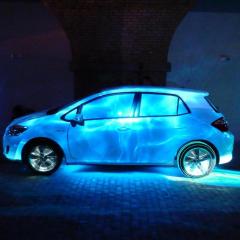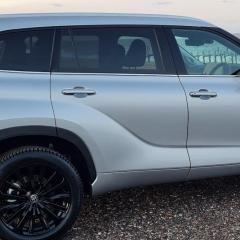Leaderboard
Popular Content
Showing content with the highest reputation on 08/03/2020 in all areas
-
Hi, that is the problem., your mechanic should never use a gun to tighten bolt and nuts, he simply over tighten them., plus when wheels are in the air he set wrong preloads then after let the car on the ground everything is so tight and rubber is not flexible anymore and under extreme pressure of the suspension arm movement up and down resulting ripped bush, next is snapped links. Buy new quality links with bushings and install correctly, you will never have any problems. 4056A052 Tha is your part number , and here you can look how fits to the car https://japancars.ru/index.php?route=catalog/mitsubishi&grp_id=33&area=M60&cat=C601H401D&mdl=Z34A&clf=XNLHR6&cfg_id=1&blk_id=1102 points
-
The bolt that is securing the bushing is the wrong one. It is not supposed to be threaded as far down as the one that is shown in your picture. I'm not a mechanic, but that threaded portion of your bolt is pointlessly long for this application. In your picture, now that the rubber bush has almost been destroyed, the anti roll bar looks to be sitting in the 'wrong' place, but that space should be filled by the rubber bush that is no longer there. This is not remotely obvious if you haven't seen the car. I think that in this application, the anti roll bar fitment's securing bolt/nut is not designed to be tightened until the rubber is so compressed that the bolt/nut goes snug when using a power tool, it is supposed to be tightened to the end of the bolt's threaded portion, at which point it can go no further. With the wrong dimension of bolt thread, this pre-loading of the bush will be wrong. Or, it could be that your mechanic has left off a metal bush that sits over the shank of the bolt, that would exist to change the bolt's effective thread length. Having a rubber bush flexing up and down on a threaded bolt shank seems like a poor (so not Mitsubishi's) design. Alternatively, if this suggestion is wrong, then a torque wrench should be used to the factory spec. But, I could be misinterpreting the photograph. Happy to be corrected.2 points
-
It means you get to listen to the radio a bit longer before the car won't start.1 point
-
This has been highlighted on earlier threads (not for RAV4 hybrid, though). You could consider buying one of these cigarette lighter socket voltmeters - there are plenty of other similar ones with, perhaps, a better appearance/build. https://www.amazon.co.uk/Digital-Cigarette-Lighter-Voltage-Voltmeter/dp/B00DE3H4G8/ref=pd_day0_c_263_2/258-4330738-9698635?_encoding=UTF8&pd_rd_i=B00DE3H4G8&pd_rd_r=75789659-63cd-4fd6-a998-e339a07a666f&pd_rd_w=BwxhY&pd_rd_wg=ufDMz&pf_rd_p=cb7ac7c9-1220-4f8e-9626-3d6840134f7f&pf_rd_r=54ZSXHTVDFKZFHYCNHSX&psc=1&refRID=54ZSXHTVDFKZFHYCNHSX When the car is turned on, but in 'accessory' mode, the 12v system is running directly from the 12v battery, which is receiving no assistance from the inverter/traction battery in that mode. So any voltage shown on the gauge (via the cigarette lighter/accessory socket) will give a good idea of the 12v battery's charge level. In your particular situation, I think the 12v battery needs a long charge (at least overnight on a charger) to get it fully topped-up. I think when you have 'broken out' of your discharged battery/flat battery 'loop' , then the car's 12v performance might seem a bit more reasonable. At the moment the 12v battery charge energy from the car during your journeys is probably the equal of the drain out of the battery over 4 days. But as you already have a battery that is very low, the car tips into non-operation - you are 'dragging along the bottom' of the battery's charge curve, maybe. The parasitic (parked up) drain on the 12v battery on these hybrids is not really different to a conventional car, but the 12v battery, which despite being made to a higher specification than older generation, conventional 12v batteries, seems to be unable to take a fast charge - which the car is almost certainly able to provide via the inverter/traction battery when the system is fully 'on'. This might be a sizeable factor in this problem. Regrettably, the more (times and duration) the battery is flattened, the smaller it's capacity becomes as well. This is true for any car battery in any car. A long-duration 'drive' (distance covered/speed will make no difference on this car) will get some charge into the battery, and this could even be with the car in traffic, or even parked on your drive, if you have one, although this is not necessarily practical for all! That's as I understand it, anyway.1 point
-
It was a straightforward question. You haven't indicated previously how you use the car, so members don't know whether you use the car in an urban environment with lots of stop/start traffic, long runs, short runs, etc, etc. Chill a bit!1 point
-
Frosty, thank you and that cleared up the speedo issue which suggests that the computer mpg displays are accurate. Speedo accuracy is also relevant, Prius or other as a stated MPG should be caveated by speed for obvious reasons.1 point
-
As you said, this has been discussed previously. Please return to the topic subject - Fuel efficient Toyota car - Prius.1 point
-
Yeah it's a riveting read. Keeps you guessing right through to the end. Turns out it was done by some bloke called Servicing Interval and I think he was a serial killer because he did it at least once every year. 🙂1 point
-
The Research Institute for Disabled Consumers provide some useful information on car accessibility, including seat heights, etc - see their reviews of the Prius and Corolla Touring Sport: https://www.ridc.org.uk/features-reviews/out-and-about/choosing-car/car/prius-18-hybrid-5dr-hatch-2019 https://www.ridc.org.uk/features-reviews/out-and-about/choosing-car/car/corolla-touring-sports-20-hybrid-5dr-estate-20191 point
-
Hi PeteB, Eco mode is my default setting. Only time I used other modes was on the test drive. But will try the other modes and CC when a opportunity arises. ( my wife isn't in the car) Regarding the rear view camera. I had the choice of 3 views options. I selected the best view and have left it as that. still disappointed with the quality of the image. MPG. still on my first tank of fuel. If I get a 2% discrepancy would be happy with that. My wife and I both agree the blind spot monitor is a good option. First time we have had it on one of our cars.1 point
-
I'm thinking that too, though visually there is nothing there. 1) One think I remembered, was about a month ago I went for an oil change to a different mechanic, he lifted the car up using a floor jack, then he used a jack stand for safety, but when he finished and lowered the car he forgot about the jack stand and the car "fell" on the jack stand with a loud metal noise. he then lifted it back up, removed the stand and I drove off, I asked and he didn't say anything was broken (he wouldn't ofc! Obviously, I will never be going back to him in the future..) but I didn't notice any clunking noises until recently.I also mentioned this to my usual mechanic, he said it's highly improbable that this would generate so much force as to bend something and that if something was indeed bend would be due to falling in a pothole at speed. 2) Is it possible the bushing fails due to a wrong installation (they lift the car, unscrew bolt, place new rubber between frame and arm, reinstall and tighten bolt, lower car. Is this the normal procedure?1 point
-
For me, I found myself obsessing about fuel economy, and driving on trunk roads as though I had an egg under my accelerator foot. I am not a boy racer (!), but I like to pull away from the lights smartly if there is nothing in front etc. I found that my economy went up if I just drive like I always have, smoothly, accelerate normally, use the hybrid indicator as a curiosity rather than a strict monitor you must follow. If you were an aggressive driver, the hybrid indicator would help you calm down. So, when I try to be ultra careful, my economy drops! It think the cars are set up this way by the engineers, as they expect you to enjoy driving them, not frightened to press the accelerator. You will work all this out, and as 2ltr owners, and they are still quite new to the Corolla Family, we are all having to learn together how to get the best from them.They do seem to be set up differently to the 1.8, including no B setting to increase charge to the battery when coasting. Some owners try using the paddles to shift down when descending a hill etc to increase braking and power to the battery. Experiment and enjoy the drive.1 point
-
its a shift interlock, (usually releases when you put you foot on the brake) if you need to take the car out of park and it has no power or something doesn't work you pop the cap off and push down on the release to move the selector1 point
-
There seems to be much confusion here. As I understand it these are the two main functions we're likely to use: 1. Hold down brake pedal and push button once to start the hybrid and drive off. In this state you can leave it in P park/READY mode if you need to wait some time in car and listen to radio or to update the mapping (which takes an hour+). The engine will periodically fire up for a few minutes to top up the battery. You would also use this mode if you are quarantining (not going out for weeks) and need to maintain the car's battery while it's out of use - for this Toyota recommend switching car on (READY mode + P park) and leaving it on for 60 mins once per week to maintain the battery. 2. NOT using the brake pedal you can press the button twice to get into ACC accessory mode where audio is available. Don't use this for more than a few minutes. Because the hybrid is not switched on it cannot come on to top up the battery so you will quickly drain the battery. Having tried all this myself I no longer bother with ACC mode so it's always number 1. for me. Note that the graphic Rivorian posted above is referring to NOT depressing the brake pedal when using the button. Easy to miss that point but crucial to understand what all those different modes mean.1 point
-
If you're refering to the thread found in the Danish Facebook Group "Toyota Hybrid Forum", I believe his car is a Yaris from 2015. I haven't heard / read about any Auris failing. What is unfortunate is that he wasn't informed by his garage that after the five year warranty period he would need to have future checks done one year TO THE DATE at the latest. I didn't know this myself until last year - my garage told me that during the 5 year warranty period of the hybrid components, Toyota is more forgiving as the check being done a few days or weeks late. Not so when the 5 year warranty has expired. I hope this is true as some of my first checks / services were a week or two overdue.1 point
-
Catlover, I think you get me wrong. I don't sit in my chair at night and think about possible failures or break downs. But it's my car, and I want to know all I can about it. The battery test is like putting the car on a dyno. Let's see what it's got. Hopefully I only gets test reports with high scores, and would be a great documention to pass on to the next owner. Since I only have 10 years warranty in Denmark, not 15 years, a potential buyer to my used car in 5-7 years could ask, if the battery is in good condition. Well, I have no idea, in that case all I have is 15 sheets of paper that says "Passed", but doesn't give any numbers or figures. A danish owner had a fatal failure on his 2013 Auris, that required a full battery exchange. He had missed his annual service by 1 month, and got stuck with the whole bill. Until the last service, the poor owner could have 6-7 sheets that says Passed, and suddently the whole thing dies. Just maybe some error has been in progress over time, and if the report had numbers and measurements, errors could have been detected at a early stage.1 point
-
Acceleration: have you tried using the various drive modes? I find in ECO mode the CC acceleration is fine (for my taste). As an experiment, you might try setting the car to ECO mode and the CC speed to 70 mph (on a suitable dual carriageway) and maybe when exiting a roundabout and traffic flow is such that it's safe to do so, hit resume. After a few seconds select normal mode then sport. That will demonstrate the different levels of acceleration available - maybe one will be to your taste. Sport mode certainly provokes some urgency when CC is accelerating. Rear Camera: have you tried the icons to switch from 180° view to normal view? It may seem less distorted, Granted the resolution, clarity and brightness of both the infotainment and instrument cluster screens are embarrassingly dismal - one reviewer I read likened it to a 1980s video game screen. Particularly disappointing is the way the bottom half of the instrument screen is almost invisible in brightish light, even when the sun is not directly on it. Computed mpg: I keep such detailed records of my fuel usage that would impress many a train spotter, and can report that the average optimism of the RAV4's display mpg is 'only' about 2% optimistic on average, whereas all previous Toyotas I've logged have been around 5% optimistic.1 point







